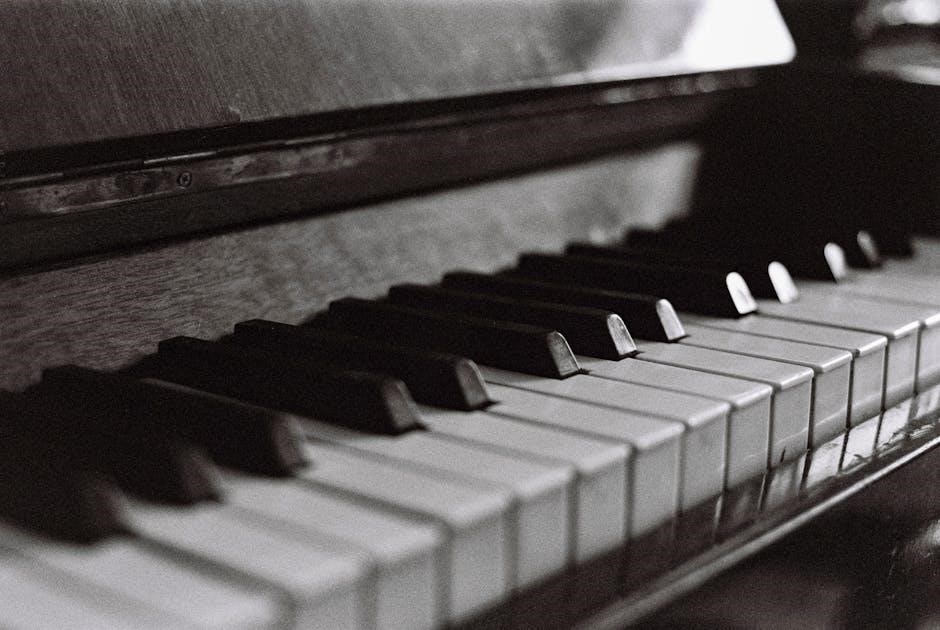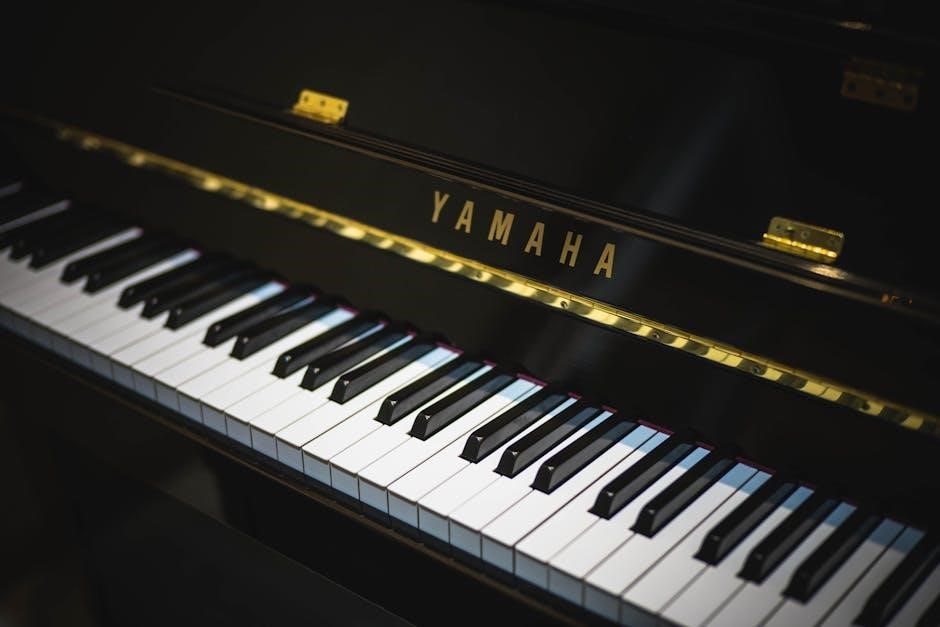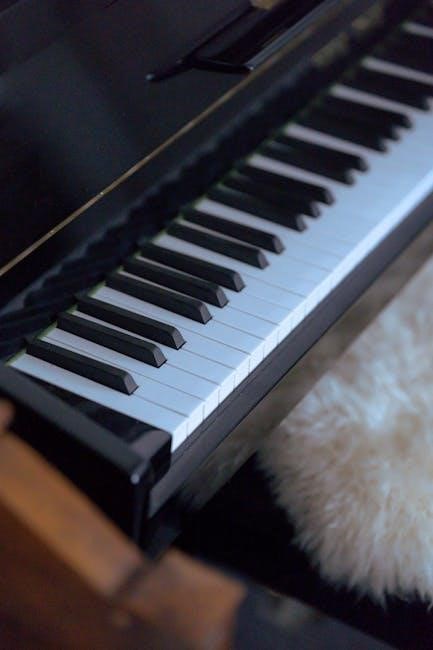
piano chord chart pdf
A piano chord chart is a visual tool displaying piano keys and chord fingerings, helping pianists understand chord structures and play harmonies․ It simplifies learning and composing music․
1․1 What is a Piano Chord Chart?
A piano chord chart is a visual representation of piano keys and their corresponding chord fingerings․ It displays the layout of the piano keyboard, highlighting the notes that make up specific chords․ This tool helps pianists quickly identify chord structures, making it easier to play harmonies and melodies․ Chord charts often include symbols and notations to indicate root notes, intervals, and inversions, providing a clear guide for constructing chords․ They are particularly useful for beginners, as they simplify the process of learning chord shapes and their variations․ By using a chord chart, musicians can focus on playing smoothly and creatively without needing to memorize every detail of chord theory․ This resource is essential for both practice and performance, offering a straightforward way to understand and execute chords effectively․
1․2 Importance of Using a Piano Chord Chart
Using a piano chord chart is essential for pianists, as it provides a clear and concise way to understand chord structures and their fingerings․ It accelerates the learning process, especially for beginners, by visually mapping out chords on the keyboard․ This tool enhances creativity, allowing musicians to experiment with different harmonies and progressions effortlessly․ Chord charts also improve sight-reading skills and enable quick identification of notes, making practice more efficient․ For experienced players, they serve as a reference to explore complex chords and variations․ Additionally, chord charts are invaluable for improvisation, as they provide a framework for creating spontaneous melodies․ By simplifying chord theory, they empower musicians to focus on expression and technique, making them an indispensable resource for both practice and performance․ Overall, a piano chord chart is a fundamental aid that fosters musical growth and mastery․
How to Use a Piano Chord Chart

Start by identifying chord symbols and matching them to keyboard notes․ Practice finger placement and transitions between chords․ Apply chords to songs by following progressions, experimenting with harmonies, and enhancing creativity․
2․1 Steps to Read a Piano Chord Chart
To read a piano chord chart, start by identifying the root note of the chord, usually marked at the top or bottom of the chart․ Next, locate the corresponding keys on the piano keyboard․ Analyze the chord structure by recognizing intervals and finger placements․ Begin with simple triads, such as C Major, and gradually progress to more complex chords like seventh chords․ Pay attention to sharps (#) or flats (♭) indicated in the chart, as they modify the pitch of the notes․ Practice playing each chord slowly, ensuring proper finger placement and hand position․ Once comfortable, experiment with transitioning between chords to apply them to songs․ Regular practice will improve your ability to interpret and perform chord charts fluently․
2․2 Understanding Chord Symbols and Notation
Chord symbols, such as C, G7, or Am, represent specific groups of notes played together․ These symbols are often displayed above the piano keys in a chord chart, indicating which notes to play․ Major chords are labeled with the note name alone (e․g․, C), while minor chords include “m” (e․g․, Cm)․ Seventh chords are marked with a “7” (e․g․, C7)․ Understanding these symbols is crucial for interpreting the chart; The notation may also include sharps (#) or flats (♭) to modify the pitch of notes․ Additionally, chord charts often use numbers or letters to denote octaves or finger placements, helping pianists navigate the keyboard efficiently․ Familiarizing yourself with these symbols and their meanings allows you to decipher chord charts quickly and accurately, making it easier to play complex harmonies and melodies․ Practice identifying and playing these chords to enhance your skills․ Use online resources or PDF guides for further clarification and practice exercises․
2․3 Applying Chords to Songs
Once you’ve learned the chords from the chart, applying them to songs is the next step․ Start by identifying the key of the song and its chord progression․ Match the chords from the chart to the progression, focusing on smooth transitions between chords․ Practice playing each chord cleanly and in rhythm․ For beginners, simple songs with common progressions like C-G-Am-F are ideal․ As you progress, explore more complex songs and variations․ Using a chord chart as a guide, experiment with different chord voicings or inversions to enhance the song’s texture․ You can also improvise by adding seventh chords or altering the bass line․ Regular practice with real songs helps build your musicality and confidence․ Utilize PDF chord charts or online tools to find chord progressions for your favorite songs and apply what you’ve learned to create beautiful music․

Benefits of Using a Piano Chord Chart
A piano chord chart serves as a visual guide, aiding pianists in understanding chord structures․ It speeds up the learning process, enhances creativity, and provides a quick reference for performances․
3․1 Advantages for Beginners
Piano chord charts are invaluable for beginners, offering a clear and organized way to learn chords without overwhelming complexity․ They provide visual representations of keys and finger placements, making it easier to grasp chord structures․ By focusing on chord shapes and their positions on the piano, beginners can quickly identify and play chords․ This simplifies practice, allowing learners to concentrate on proper hand placement and fingerings․ Additionally, chord charts enable beginners to play songs sooner, boosting confidence and motivation․ Many free PDF chord charts are available online, catering to different skill levels․ These resources often include diagrams and step-by-step guides, helping novices understand music theory basics․ Customizable charts can also be created to focus on specific chords or progressions, making the learning process more tailored and efficient․ Overall, piano chord charts make learning accessible, enjoyable, and systematic for those starting their musical journey․
3․2 Enhancing Creativity and Improvisation
Piano chord charts are powerful tools for fostering creativity and improvisation․ By providing a visual map of chords and their relationships, they enable pianists to explore harmonies and progressions intuitively․ This understanding allows for spontaneous experimentation, as musicians can see how chords connect and flow․ Chord charts also simplify the process of composing music, as they offer a clear framework for building melodies and harmonies․ For improvisation, they serve as a reference point, helping pianists navigate key signatures and chord substitutions seamlessly․ Additionally, charts encourage exploration of inversions, altered chords, and modal interchange, expanding creative possibilities․ With chord charts, musicians can focus less on theory and more on expression, making the process of creating music more fluid and enjoyable․ This visual guidance empowers pianists to think outside the box and craft unique, engaging performances;

Types of Piano Chords Covered in a Chord Chart
Piano chord charts typically include major, minor, seventh, diminished, and augmented chords, each with their own unique structures and functions in music composition and performance․
4․1 Major and Minor Triads
Major and minor triads are the foundation of piano chord charts․ A major triad consists of a root, major third, and perfect fifth, creating a harmonious sound․ Minor triads replace the major third with a minor third, producing a sadder, more introspective tone․ These triads are essential for understanding chord progressions and harmonic structure․ They are often visualized on chord charts with the root note at the base, followed by the third and fifth․ Practicing these basic chords helps pianists build finger strength and musical understanding․ By mastering major and minor triads, pianists can easily expand into more complex chords like sevenths and diminished chords, enhancing their ability to play and compose various styles of music effectively․
4;2 Seventh Chords
Seventh chords add depth and complexity to music by extending triads with an additional seventh interval․ They are categorized into types like major seventh, minor seventh, and dominant seventh chords․ Major seventh chords combine a major triad with a major seventh, creating a rich, resonant sound․ Minor seventh chords blend a minor triad with a minor seventh, often used in jazz and blues for emotional expression․ Dominant seventh chords, formed by a major triad and a minor seventh, are foundational in many musical genres․ Piano chord charts visually represent these chords, making it easier for pianists to identify and play them․ Practicing seventh chords enhances harmonic understanding and expands musical versatility, allowing pianists to explore intricate compositions and improvisations with confidence․
4․3 Inversions and Altered Dominants
Inversions refer to the rearrangement of a chord’s notes, creating different harmonic textures․ A root position chord has its root as the lowest note, while first and second inversions place the third and fifth in the bass, respectively․ Altered dominants are dominant chords with modified extensions, such as flat or sharp fifths and ninths, adding color and tension․ These chords are often used in jazz and blues to create complex, emotionally rich harmonies․ Piano chord charts frequently include inversions and altered dominants, providing pianists with a clear visual guide to these advanced chord structures․ Understanding and practicing these techniques can elevate a pianist’s ability to play nuanced, sophisticated music with depth and variety․
4․4 Diminished and Augmented Chords
Diminished chords consist of a root, minor third, and diminished fifth, creating a tense, unstable sound often used in transitions․ Augmented chords include a root, major third, and augmented fifth, producing a bright, expansive quality․ Both are less common than major or minor chords but add unique color to music․ In piano chord charts, these chords are typically represented with symbols like “dim” or “+” to indicate their alterations․ Understanding diminished and augmented chords enhances a pianist’s harmonic palette, allowing for more nuanced compositions and performances․ They are particularly useful in jazz and classical music for creating intricate harmonies and emotional depth․ By studying these chords, pianists can expand their musical expression and explore advanced keyboard techniques effectively․

Creating a Custom Piano Chord Chart
Design a personalized chart by selecting specific chords, keys, and progressions․ Use software tools to generate and organize chords, ensuring they align with your musical needs and preferences effectively․
5․1 Designing Your Own Chart
Designing a custom piano chord chart allows you to tailor it to your specific needs․ Start by identifying the chords and keys you frequently use․ Consider the type of music you play, such as jazz, pop, or classical, and include relevant chords․ Use graph paper or digital tools to sketch the layout, ensuring it’s visually organized․ Label each chord clearly, noting its notes and fingerings․ You can also include chord progressions or scales for quick reference․ Adding color coding or symbols can enhance readability․ Finally, test your chart by playing the chords to ensure accuracy․ This personalized approach ensures your chart is practical and efficient, making it easier to learn and perform music․ By designing your own chart, you can streamline your practice and performance routines․
5․2 Using Software to Generate Chords
Utilizing software to generate piano chords is a modern and efficient way to create custom chord charts․ Programs like MuseScore, Finale, and Logic Pro X offer tools to input chords and display them in a chart format․ These applications often include libraries of predefined chords, allowing you to drag and drop them into your chart․ Additionally, some software enables real-time editing, where you can hear the chords as you arrange them․ For pianists with basic computer skills, these programs are user-friendly and save time compared to manually drawing charts․ Many tools also support MIDI compatibility, letting you import and export chord progressions seamlessly․ By leveraging software, you can create professional-looking charts tailored to your needs, making practice and performance more organized and enjoyable․ This method is ideal for both beginners and experienced pianists looking to streamline their workflow․
5․3 Including Chord Progressions
Incorporating chord progressions into your piano chord chart enhances its functionality, making it a valuable resource for composing and practicing․ A chord progression is a sequence of chords played in a specific order, forming the harmonic foundation of a song․ By including these progressions, your chart becomes a roadmap for playing songs smoothly․ Start by identifying common progressions, such as the I-IV-V pattern, which is prevalent in popular music․ Next, map these chords onto your chart, ensuring each chord is clearly labeled and positioned․ This visual arrangement helps in understanding how chords transition and relate to one another․ For added clarity, use arrows or lines to indicate the flow between chords․ Including chord progressions not only aids in learning songs but also fosters creativity, allowing you to experiment with variations and improvisations․ This feature is particularly beneficial for beginners, as it provides a structured approach to playing harmonies and melodies together․

Learning Piano Chords with a Chord Chart
A piano chord chart simplifies learning by visually organizing chords, making it easier to understand keys and compose music․ It’s an essential tool for mastering harmonies and melodies effectively․
6․1 Tips for Practicing Chords
Start by practicing chords slowly, focusing on finger placement and hand position․ Use a metronome to improve timing and rhythm․ Begin with simple triads, gradually incorporating seventh chords․ Play chords in all keys to enhance versatility․ Practice chord progressions commonly used in songs․ Use a piano chord chart to visualize fingerings and note positions․ Experiment with improvisation to apply chords creatively․ Dedicate time daily to build muscle memory and dexterity․ Record sessions to track progress and identify areas for improvement․ Incorporate exercises like scales and arpeggios to strengthen chord transitions․ Play along with recordings to develop ensemble skills․ Consistency is key to mastering chords effectively․
6․2 Common Chord Progressions
Common chord progressions provide a foundation for countless songs․ The I-IV-V-I progression is widely used in pop and rock music, while the I-vi-IV-V pattern is popular in ballads․ Jazz often employs the ii-V-I progression, offering harmonic complexity․ Blues music relies on the 12-bar blues structure, cycling through I, IV, and V chords․ These progressions are fundamental for improvisation and composition․ Learning them enhances versatility and understanding of musical structure․ Start by practicing these progressions in different keys to build familiarity․ Experimenting with variations can inspire creativity and lead to new compositions․ Using a piano chord chart can help visualize these progressions and their relationships․ Mastering common chord progressions is essential for pianists aiming to play or compose music effectively․
6․3 Exercises for Mastery
Mastering piano chords requires consistent practice and targeted exercises․ Start with finger independence exercises to build dexterity․ Play scales and arpeggios to improve finger strength and familiarity with keys․ Practice transitioning smoothly between chords, focusing on common progressions․ Begin with slow tempos and gradually increase speed․ Incorporate chord drills, such as switching between I, IV, and V chords in different keys․ Experiment with playing chords in various inversions to enhance versatility․ Practice playing chords with both hands, ensuring harmony and balance․ Use metronomes to improve timing and rhythm․ Apply chords to simple melodies to reinforce practical application․ Sight-reading chord charts regularly sharpens your ability to interpret and play chords accurately․ Consistent practice and varied exercises will lead to mastery and confidence in playing piano chords․

Resources for Downloading Piano Chord Charts
Access free PDF chord charts online or explore paid workbooks for comprehensive guides․ Apps like forScore and Newzik also offer chord charts for convenient practice․ Visit sheetmusicplus․com for more resources․
7․1 Free PDF Downloads
Free piano chord chart PDFs are widely available online, offering convenient access to chord diagrams and progressions․ Websites like sheetmusicplus․com and pianochordcharts․com provide downloadable charts for various skill levels․ These PDFs often include major, minor, and seventh chords, along with finger placement guides․ Apps like forScore and Newzik also support PDF chord charts, making them easy to use on tablets․ Additionally, platforms like musicnotes․com offer free chord charts for popular songs․ These resources are ideal for beginners and experienced pianists alike, allowing quick reference during practice or performance․ Many PDFs are customizable, enabling users to focus on specific chords or progressions; Downloading free chord charts is a great way to enhance your piano learning journey without any cost․
7․2 Paid Resources and Workbooks
Paid resources and workbooks offer comprehensive and detailed piano chord charts, often tailored for specific genres or skill levels․ Websites like musicnotes․com and sheetmusicplus․com provide premium PDF downloads with advanced features such as interactive chord diagrams and progressions․ Workbooks like The Piano Chord Bible and Jazz Piano Chords are highly recommended for in-depth learning․ These paid materials often include video tutorials, practice exercises, and detailed theory explanations․ They cater to both beginners and advanced pianists, ensuring a structured approach to mastering chords․ Investing in paid resources can enhance your learning experience by offering organized and professional content, making it easier to progress in your piano journey․ These resources are particularly useful for those seeking a systematic and comprehensive understanding of piano chords and their applications․
Piano chord charts are invaluable tools for mastering chords and composing music, offering clear guidance for pianists of all levels to explore and express musical ideas effectively and creatively;
8․1 Final Thoughts on Using a Piano Chord Chart
Using a piano chord chart is an effective way to streamline your learning process and enhance your musical creativity․ Whether you’re a beginner or an advanced pianist, these charts provide a clear and concise visual representation of chords, making it easier to understand and play complex harmonies․ They are particularly useful for those who prefer a structured approach to learning music theory and composition․ By referencing a chord chart, you can quickly identify chord fingerings, intervals, and progressions, saving time and effort․ This tool is especially beneficial for improvisation and composing, as it allows for rapid experimentation with different chord combinations․ Over time, consistent use of a chord chart can deepen your understanding of music theory and improve your overall playing skills․ Embrace this resource to unlock new musical possibilities and refine your craft․

Appendix
9․1 Glossary of Terms

A glossary of essential terms related to piano chord charts, including definitions of chords, triads, inversions, and other musical concepts to enhance understanding and application of chord charts․

A triad is a basic chord made of three notes: the root, third, and fifth․ A major chord has a happy sound, while a minor chord sounds sad․ A seventh chord adds a seventh note for depth․ Inversion occurs when the root isn’t the lowest note․ The root is the fundamental note of a chord․ An octave is the interval between two notes of the same pitch․ Diminished and augmented chords alter the fifth for unique sounds․ A chord progression is a series of chords in a song․ These terms help pianists understand and use chord charts effectively․

